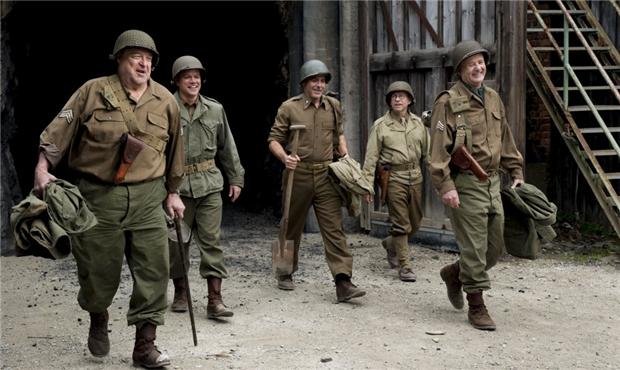
New aphorism: With great casting, comes great responsibility. I’ve heard people say, of The Monuments Men,
“with a cast like that, you can’t go wrong!” Actually, the opposite is
true. When a cast includes the likes of Cate Blanchett, Matt Damon, Bill
Murray, John Goodman, and George Clooney (who also directed and
co-wrote), expectations are raised. And if the film doesn’t deliver,
it’s doubly disappointing.
At least I can see why everyone signed on (the cast also includes Downton Abbey’s Hugh Bonneville, The Artist’s
Jean Dujardin, and redoubtable character actor Bob Balaban). The
story—based on real events—is a doozy. During World War II, a carefully
selected team of curators, art historians, architects, et al were
recruited to hunt down and recover priceless works of art that the Nazis
had stolen. You see, Hitler, with classic hubris, had hoped to create
the world’s greatest art museum. (I’m yet to see a movie about Hitler
that doesn’t mention his thwarted aspirations as an artist and The Monuments Men
doesn’t disappoint—although in this case, I suppose, it’s appropriate.)
The recruits, mostly middle-aged and, in some cases, too drunk or
feeble of body to have served themselves, were given the half-hearted
blessing of Roosevelt and later, half-hearted cooperation from their
fellow soldiers (who were more concerned with carrying out military
orders and surviving the war than preserving art). They went through
basic training and then, dubbed Monuments Men, tirelessly searched the
front lines of Belgium, France, and Germany for the stolen work, often
risking their own lives.
The gifted Blanchett has possibly the
most interesting part—as a member of the French resistance working
undercover as a bookkeeper/art historian for the Nazis. But again, she
isn’t given much to do, and a potential romance with Matt Damon’s James
Granger is so flimsy and half-baked, I’m not even sure why they
bothered.
Most of the film is a series of set pieces: A raid on a
church, a roadside ambush, an encounter with an unexpected sniper, but
it’s remarkable how low the stakes feel and how little we’re invested in
the characters. This is because Clooney—who plays Frank Stokes, the
group’s leader—fails to make each character distinct enough. Bill Murray
gives us his patented amused deadpan and John Goodman mugs
extravagantly as only John Goodman can, but we’re never quite sure why.
(The film, which fancies itself a kind of Raiders of the Lost Masterworks,
also balances its mix of comedy and drama somewhat awkwardly.) Then,
adding insult to injury, Clooney does an earnest voiceover about the
power of art that feels dangerously mansplainy.
Another quibbles:
The period details never convince. A makeshift walkie talkie is as
crystal clear as the latest 4G from Verizon; likewise, a 45 record
containing a greeting from home for Murray’s character sounds like it
was digitally mastered in a studio. (What’s more, since we know next to
nothing about Murray or his family, the scene of him listening to the
greeting, in near tears, fails to move.)
There are a few pretty
good moments—a comical interlude involving Matt Damon and a landmine; a
scene at a Nazi’s farm house where Balaban’s Preston notices that the
Renoir “reproductions” on the walls are really, really good
—but this should have been pulse-pounding stuff. Instead it feels static
and bland, with an overqualified cast and, for this film at least, a
director not quite up to the task.
